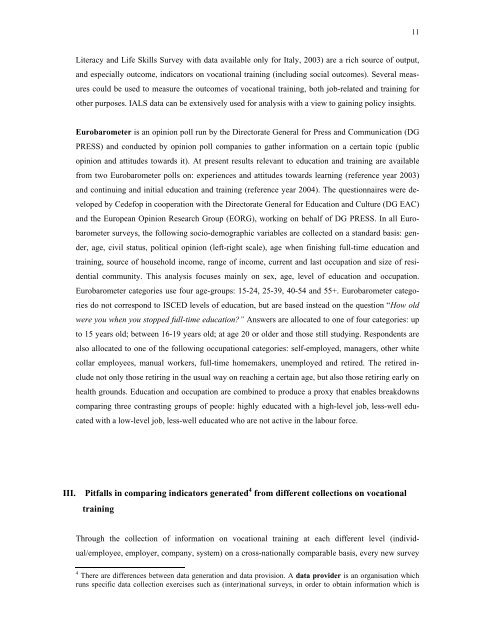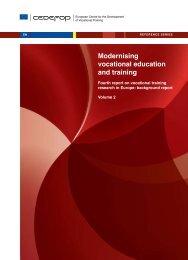measuring the outputs and outcomes of vocational training
measuring the outputs and outcomes of vocational training
measuring the outputs and outcomes of vocational training
You also want an ePaper? Increase the reach of your titles
YUMPU automatically turns print PDFs into web optimized ePapers that Google loves.
11<br />
Literacy <strong>and</strong> Life Skills Survey with data available only for Italy, 2003) are a rich source <strong>of</strong> output,<br />
<strong>and</strong> especially outcome, indicators on <strong>vocational</strong> <strong>training</strong> (including social <strong>outcomes</strong>). Several measures<br />
could be used to measure <strong>the</strong> <strong>outcomes</strong> <strong>of</strong> <strong>vocational</strong> <strong>training</strong>, both job-related <strong>and</strong> <strong>training</strong> for<br />
o<strong>the</strong>r purposes. IALS data can be extensively used for analysis with a view to gaining policy insights.<br />
Eurobarometer is an opinion poll run by <strong>the</strong> Directorate General for Press <strong>and</strong> Communication (DG<br />
PRESS) <strong>and</strong> conducted by opinion poll companies to ga<strong>the</strong>r information on a certain topic (public<br />
opinion <strong>and</strong> attitudes towards it). At present results relevant to education <strong>and</strong> <strong>training</strong> are available<br />
from two Eurobarometer polls on: experiences <strong>and</strong> attitudes towards learning (reference year 2003)<br />
<strong>and</strong> continuing <strong>and</strong> initial education <strong>and</strong> <strong>training</strong> (reference year 2004). The questionnaires were developed<br />
by Cedefop in cooperation with <strong>the</strong> Directorate General for Education <strong>and</strong> Culture (DG EAC)<br />
<strong>and</strong> <strong>the</strong> European Opinion Research Group (EORG), working on behalf <strong>of</strong> DG PRESS. In all Eurobarometer<br />
surveys, <strong>the</strong> following socio-demographic variables are collected on a st<strong>and</strong>ard basis: gender,<br />
age, civil status, political opinion (left-right scale), age when finishing full-time education <strong>and</strong><br />
<strong>training</strong>, source <strong>of</strong> household income, range <strong>of</strong> income, current <strong>and</strong> last occupation <strong>and</strong> size <strong>of</strong> residential<br />
community. This analysis focuses mainly on sex, age, level <strong>of</strong> education <strong>and</strong> occupation.<br />
Eurobarometer categories use four age-groups: 15-24, 25-39, 40-54 <strong>and</strong> 55+. Eurobarometer categories<br />
do not correspond to ISCED levels <strong>of</strong> education, but are based instead on <strong>the</strong> question “How old<br />
were you when you stopped full-time education” Answers are allocated to one <strong>of</strong> four categories: up<br />
to 15 years old; between 16-19 years old; at age 20 or older <strong>and</strong> those still studying. Respondents are<br />
also allocated to one <strong>of</strong> <strong>the</strong> following occupational categories: self-employed, managers, o<strong>the</strong>r white<br />
collar employees, manual workers, full-time homemakers, unemployed <strong>and</strong> retired. The retired include<br />
not only those retiring in <strong>the</strong> usual way on reaching a certain age, but also those retiring early on<br />
health grounds. Education <strong>and</strong> occupation are combined to produce a proxy that enables breakdowns<br />
comparing three contrasting groups <strong>of</strong> people: highly educated with a high-level job, less-well educated<br />
with a low-level job, less-well educated who are not active in <strong>the</strong> labour force.<br />
III. Pitfalls in comparing indicators generated 4 from different collections on <strong>vocational</strong><br />
<strong>training</strong><br />
Through <strong>the</strong> collection <strong>of</strong> information on <strong>vocational</strong> <strong>training</strong> at each different level (individual/employee,<br />
employer, company, system) on a cross-nationally comparable basis, every new survey<br />
4 There are differences between data generation <strong>and</strong> data provision. A data provider is an organisation which<br />
runs specific data collection exercises such as (inter)national surveys, in order to obtain information which is








